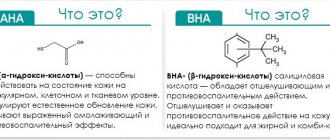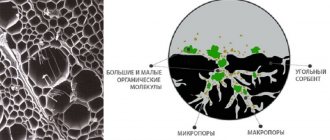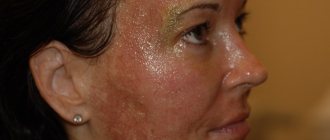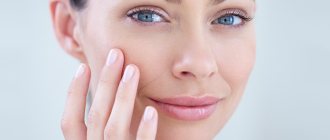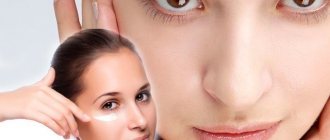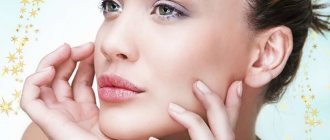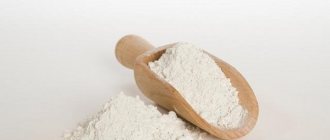Salicylic acid is well known to us since childhood. When there was not such a variety of special products for the care of problem skin as there is now, a dark brown pharmaceutical bottle often helped teenagers out in difficult situations. And although salicylic peeling has been used in cosmetology for quite a long time, today it has not lost its effectiveness and popularity. Doctors at our clinic recommend this procedure as a reliable remedy for treating oily and problematic skin.
What is salicylic peeling?
Salicylic peeling is one of the types of chemical peeling, which is carried out using salicylic acid of varying concentrations (it refers to BHA acids). Salicylic peeling does not damage the deep layers of the epidermis, so recovery will occur as quickly as possible.
One of the features of salicylic peeling is its effect. Dead cells are dissolved rather than scraped off, as happens with many other types of peeling. Salicylic acid breaks down the protein layers and causes exfoliation of the stratum corneum of the epidermis. As a result, the skin becomes noticeably cleaner, smoother, younger and more beautiful, comedones and blackheads disappear. With the help of peeling, you can lighten pigmentation, smooth out wrinkles, destroy pathogenic bacteria that cause acne and narrow pores.
To achieve the best results, it is recommended to combine salicylic peeling with other types of peeling, as well as various facial cleanses. The procedure perfectly helps to get rid of various inflammations, normalize the activity of the sebaceous glands, cleanse the skin, even out the complexion, smooth out the microrelief, smooth out facial wrinkles. Please note that after salicylic peeling, you cannot use cosmetics that contain zinc oxide and resorcinol.
Operating principle and effectiveness of the method
Let us immediately remember that chemical peels are divided into three types according to the depth of their effect on the skin: superficial, medium and deep. The latter is comparable to surgical intervention; it is performed only in a hospital setting and often under general anesthesia. Therefore, it is not suitable for us, and salicylic acid is not the component that can have such an effect.
Peeling with salicylic acid at home can be done:
- surface. Acid is used in a concentration of 15-20%. The procedure ideally solves the problems of oiliness, acne formation and comedones. But depending on the components of the home remedy, it can be used for normal and even dry skin to remove dead epidermal cells and get rid of age spots;
- Mid-superficial peeling is carried out using a 20-30% acid solution. This procedure has a very good effect on aging skin, eliminates fine wrinkles, increases elasticity and has a slight lifting effect due to stimulation of internal processes.
Now is the time to figure out what beneficial effects this miracle component has on our skin.
- Chemical peeling with salicylic acid is capable of qualitatively exfoliating the upper dead layer of epidermal cells, while stimulating active regeneration processes.
- From the inside it destroys the structure of comedones and sebaceous plugs. Literally dissolves dirt and the contents of enlarged pores and excretory ducts. After just 3-4 sessions, all these unpleasant phenomena disappear.
- Has protective properties. The acid prevents the appearance of new acne and the development of pimples. The skin becomes more resistant to irritating factors.
- There is a rapid restoration of the water-lipid layer. The production of collagen and elastin is stimulated, and the rate of breakdown of hyaluronic acid is reduced. Due to this, the procedures have a rejuvenating effect and prevent the appearance of wrinkles and premature aging of the skin.
- The acid has a powerful whitening effect. Perfectly eliminates hyperpigmentation, marks from acne and acne, burns and wounds. Fights such serious phenomena as acne of 1st and 2nd severity, seborrheic dermatitis and other pathological manifestations.
- Blood microcirculation is normalized. As a result, oxygen respiration and nutrient absorption improves. The relief becomes even and smooth, and the unnatural skin tone disappears.
Despite the superficial effect of salicylic acid, internal processes in the epidermis and even the dermis improve. This peeling is recommended for women and men at any age, because it solves completely different problems. But despite all the positive qualities, there are some limitations.
What types of salicylic peels are there?
There are two types of salicylic peeling for the face: superficial and medium. Superficial peeling is carried out with acid, concentration from 15 to 20%. It is usually performed on young skin prone to acne and comedones. Superficial salicylic peeling has a refreshing, cleansing and antiseptic effect, reduces oiliness and porosity of the skin, and reduces the number of acne. Medium facial peeling with salicylic acid is carried out on the basis of 25 or 30% acid. Deeper cleansing helps fight the signs of age, smoothes wrinkles and helps lighten pigmentation.
The process of cell exfoliation occurs in different ways. The thinner your skin, the faster the exfoliation will occur. The exfoliation process is also affected by the acid concentration - the higher it is, the faster the exfoliation will occur. There are cases when peeling of the skin does not occur at all - it depends on the skin and how it reacts to the composition.
If after the salicylic peeling procedure swelling, blisters, hyperemia, and soreness of the skin appear, consult a specialist. As a rule, this is how individual intolerance to the drug or allergy manifests itself.
Peeling: before and after
Before starting the procedure itself, it is strongly recommended to carry out a set of preparatory measures: consult a doctor and identify possible allergies; to avoid the occurrence of herpes, undergo a course of treatment with immunomodulators; prepare the skin by washing for two weeks with diluted lemon juice (only natural!) in a ratio of one teaspoon per glass of warm boiled water.
After the procedure is over, you may be alerted by strange sensations: the skin seems to be tight. Cosmetic products will help cope with excessive dry skin - primarily moisturizing and nourishing creams, which contain hyaluronic acid, amino acids, proteins, urea, hydrogels, alginates. However, be careful in your choice. Only a doctor can accurately determine the remedy that is right for you.
Active consumption of still water will help restore the lipid barrier, as well as the use of cosmetics containing antioxidants, ceramides and phospholipids, lanolin and wax, panthenol and natural oils - it will have a healing effect.
Indications and contraindications for salicylic peeling
Salicylic peeling can be performed on people over 20 years of age. It happens that according to indications and at the time of the skin condition during puberty, the procedure can be performed earlier than this age. Indications for chemical salicylic peeling include the following:
- Acne;
- Comedones: open and closed;
- Acne;
- Increased activity of the sebaceous glands;
- Post-acne and pigmentation;
- Earthy complexion;
- Loss of elasticity and expression lines;
- Enlarged pores;
- Dryness, tightness of the skin;
- Hyperkeratosis;
- Seborrheic dermatitis;
- Folliculitis.
When is this procedure needed?
We recommend booking a salicylic peel in the following cases:
- You have very oily or breakout-prone skin, and regular products won't help.
- You are tormented by acne and its consequences.
- The skin has lost its former elasticity, become flabby, folds and wrinkles have formed.
- You want to get rid of freckles or age spots.
The best time for peeling is autumn and winter. There is very little sun during this period, and your skin will be in less danger than in summer. In addition, peeling will be an excellent prevention of unwanted pigmentation.
How to prepare for salicylic peeling?
In order for the procedure to be as safe, productive and to produce the desired results, you need to properly prepare for it. Two weeks before the expected session, it is important to avoid visiting the sauna, steam bath, hammam, swimming pool, solarium and not sunbathing.
During basic skin care, it is recommended to use products that contain a small dose of salicylic acid to help the epidermis get used to this component or cosmetics designed to prepare the skin for peeling. During the preparatory period, you should not use gommages, scrubs and other peels, and actively protect your skin from the sun using products with a high SPF level.
Recommendations and possible complications after peeling
In order not to get confused in the recommendations, we decided to arrange them for you according to the time criterion. So:
- on the first day, washing, using cosmetics and creams, physical touching, and leaving the room are contraindicated;
- From the 2nd to the 14th day, experiments with cosmetics, exposure to ultraviolet rays (both solar and artificial), visiting saunas and baths, hot baths, walking without protective cream, stressful situations, active physical activity, and drinking alcohol are not allowed. and scrub procedures;
- The general rule is not to forcefully exfoliate your skin. It is necessary to wait for complete healing, after which all problems will disappear on their own. Do-it-yourself activities in the early stages can lead to scars!
Swelling, redness, dehydration, burns and peeling are natural side effects of peeling. The solution is to use protective, moisturizing and nourishing creams, medications high in antioxidants, drinking water, and physical and emotional rest.
However, complications are possible that require specific therapy: for example, in the event of herpes, antiherpetic drugs are prescribed in combination with pulse therapy; the active appearance of acne is blocked by zinc-containing products and antiseptics for external use; in case of pigmentation disorders, drug treatment is determined by the doctor, and allergic reactions will be avoided by preliminary examination and the use of antihistamines and hypoallergenic drugs.
Side effects disappear on their own within a few days (with proper care). It is impossible to predict their appearance, since each person’s body has its own individual characteristics. If we talk about complications, they usually do not arise on their own, which means that the prerequisites for their occurrence were violations of the rules of the procedure or care during the rehabilitation period.
How is salicylic peeling performed in the salon?
The first step is to cleanse your skin of makeup and other impurities. Then you can apply a special product to thin and sensitive areas that will protect the epidermis from aggressive influences. The next step is to apply the required concentration of salicylic acid to the skin using a cosmetic brush. The time for chemical salicylic peeling is individual, depending on the condition of the skin and the concentration of the drug. However, the minimum exposure time for salicylic acid on the skin is 10 minutes.
Removal of the salicylic acid composition is carried out using plain water, after which you can apply a moisturizing or nourishing cream, but without fruit acids, as well as a soothing mask that will instantly relieve discomfort.
The average number of chemical salicylic peeling sessions is 10 procedures. This figure may vary depending on the condition of the skin and the problems that need to be solved. For some, 3 procedures will be enough, while for others, 15 sessions will be necessary. It is important to maintain a certain amount of time between procedures: salicylic peeling can be performed once every two weeks.
The salicylic facial peeling procedure is not recommended during periods of increased solar activity, especially if you cannot avoid being outside. The optimal time for sessions is cloudy weather or evening.
After salicylic peeling, the skin will begin to peel off after 2-3 days. At this time, redness, a feeling of tightness and other discomfort may also appear.
How to care for your skin after procedures
After using peeling with salicylic alcohol, acid or aspirin, the skin needs careful care. After all, even such a minimal exposure to a chemical causes a slight burn. Don't be alarmed, this is what we wanted!
But remember a few simple rules so that your face will delight you with its radiant appearance:
- limit your exposure to the sun. When outdoors during the warm season, wear wide-brimmed hats and use sunscreen at all times;
- do not visit sunnas, baths, beaches and other places with high humidity and temperature for a week;
- be sure to use a special post-peeling gel or other skin soothing product immediately after the procedure;
- Apply cream to your face twice a day depending on your skin type and temporary purpose (day, night);
- Never remove flaking scales with your hands and do not scrub the skin during periods of intense peeling. It is better to lubricate your face with moisturizer more often.
If you use a store-bought product for salicylic peeling and see on the packaging that you don’t need any special care after using it (you don’t even need to use cream!) – don’t believe it. This is just a PR stunt that has no basis in fact. You need to take care so that your face acquires the desired appearance and does not become covered with spots and irritations.
Almond peeling with Azelaic acid
DermaQuest Almond Peeling contains : mandelic acid 10%, Azelaic acid 2%, Hibiscus flower extract and Lilac lilac stem cells.
Relieves the severity of inflammation and dries out rashes immediately after the first procedure. In order to increase efficiency and concentration, application of up to 3 layers is permissible.
Indications:
- Pustules – the presence of pustular elements with a low degree of activity;
- Post-acne pigment spots;
- Increased production of sebum - in the composition of Lilac Stem Cells - sebostatic effect;
- Hyperkeratosis and inflammation - indicated for rosacea;
What are enriched peelings?
Enriched DermaQuest peelings are non-seasonal and atraumatic peelings that are comparable in effectiveness to medium peels.
How enriched peels work:
Enriched peels contain low concentrations of AHAs , which work for gentle exfoliation and elimination of hyperkeratosis, and also act as enhancers - they form channels for deep penetration of the active substances included in the enriched peeling.
Active substances carried deep into the skin : peptides, plant stem cells, brightening ingredients, sebum-regulating, antioxidants, moisturizing.
Benefits of enriched peelings:
Enriched peelings are an opportunity to individually select a peeling to solve a specific problem (age-related changes, problematic skin, pigmentation, etc.) for a specific skin type (dry, oily, sensitive, irritated).
- Absolutely safe to use; they do not cause peeling, skin irritation or post-peeling hyperpigmentation.
- Maximum efficiency with minimal trauma.
The benefits of regular intensive care
Our skin consists of several layers. The top layer, the epidermis, is constantly renewed: dead cells are exfoliated and replaced by young ones. It is on this systemic “circulation” that youth and healthy skin depend. With age and under the influence of other factors, the process of cell renewal slows down. As a result, the complexion becomes dull, pores become clogged, and the skin looks uneven. Peels can prevent such problems.
Enzyme peeling Papaya Enzyme Peel, 150 ml
Peeling with lactic acid Lactica Exfoliate, 150 ml
Regenerating Azelaic peeling with azelaic acid, 150 ml
Regular exfoliation helps not only to cleanse the skin of the keratinized layer of cells, but also to cope with the effects of acne, blackheads, age spots, and make scars less noticeable. With a systematic approach, peeling fights the first signs of aging and corrects existing ones: smoothes the skin, eliminates facial wrinkles, improves complexion, makes the skin more hydrated and smooth.
How to choose a chemical peel for problem skin
So in what cases is chemical peeling indicated for problem skin:
- Mild to moderately severe forms of acne
- Inactive process of appearance of new rashes
- Performed at least once every 2 weeks
Let's look at the rules for selecting peels for problem skin using the example of specific peels from the DermaQuest line of enriched peels.
Recipes for salicylic facial peeling at home
You can prepare salicylic peeling at home yourself using proven recipes. There are a large number of home remedies and methods that use additional ingredients that have beneficial effects on the skin.
For dry skin
The dry type, prone to irritation, needs more gentle formulations. To prepare the product, you need to crush two tablets of acetylsalicylic acid and add to them the yolk and a spoonful of sour cream. Treat the skin with salicylic alcohol, apply the product in a thick layer for 10 minutes, without rubbing. Wash off with warm water and baby soap. To achieve greater effect, 6 to 8 similar procedures will be required.
For oily skin
The recipe for correcting the imperfections of oily skin is very simple. You will need to mix the powder of two aspirin tablets with a tablespoon of water, and add aloe vera gel as a thickener. First, the skin must be degreased with a solution of salicylic alcohol, and then apply the mixture for 8–10 minutes with light massage movements. Rinse off the mask with cool water and lubricate your face with moisturizer.
The permissible number of cleanings per week is no more than two. The total number of procedures is 10.
Rejuvenating
Banana-salicylic facial peeling at home is suitable for aging skin that lacks nutrients. It is prepared from 4 crushed aspirin tablets, yolk and a small amount of banana pulp. The mass is applied to the face with a brush and left for several minutes, after which it is removed with cotton pads soaked in a soda solution.
After this procedure, the skin looks more radiant and youthful. After 8-10 procedures, some age-related deficiencies can be corrected.
https://youtu.be/Hoc3bQBmYMg
With herbs
Salicylic exfoliation based on herbal decoctions is a superficial procedure. The main advantage of this type of peeling is its gentle effect, so the likelihood of a burn is very low.
To prepare herbal infusions, cosmetologists recommend using chamomile and calendula. These plant components normalize skin condition and reduce the tendency to irritation.
Chamomile is famous for its anti-inflammatory properties, and peeling based on it helps get rid of the unpleasant feeling of skin tightness. To prepare you need:
- Prepare a chamomile infusion by pouring one tablespoon of the herb into a glass of boiling water.
- Let the mixture brew for 20 minutes under the lid and strain.
- Grind one tablet of acetylsalicylic acid.
- Mix aspirin with one tablespoon of broth.
- Add a teaspoon of rich face cream and stir.
- Apply to skin.
- Massage with your fingertips for 2-3 minutes.
- Wait 5 minutes.
- Rinse off with warm water.
Calendula has equally beneficial properties and helps fight acne and blackheads, and heals small wounds. To prepare the medicinal composition, you will need dried calendula flowers, which can be purchased at the pharmacy.
Instructions for preparing the product:
- Grind the acetylsalicylic acid tablet.
- Add a tablespoon of decoction and a small amount of starch to the powder to obtain a paste-like consistency.
- Apply the composition to the skin.
- Rub thoroughly over entire face, paying special attention to problem areas.
- Wait a third of an hour for the components to penetrate the top layer, rinse with warm water.
With egg
Cosmetics containing chicken eggs help enrich the skin with beneficial microelements. However, peelings made on their basis have a rather aggressive effect on the skin due to the high concentration of the active component. Therefore, with their help you can remove even small scars and refresh your face. Depending on the condition of the skin, you can add cream or cinnamon to the product.
For those who want to improve their complexion, you will need a product with cinnamon. It not only improves skin tone, but also improves metabolic processes in the deep layers and increases blood circulation.
The composition is prepared from 4 crushed aspirin tablets, yolk and a teaspoon of cinnamon. Apply the product to the face and gently massage the skin for 5 minutes. The same amount of time should be allocated for more thorough absorption of the composition. Wash off the drug with a weak solution of soda, and then carefully rinse your face with clean water.
If your skin is prone to dryness and flaking, you can use a universal recipe for chemical exfoliation with cream. To prepare, you will need a powder made from 4 tablets of acetylsalicylic acid, a small chicken egg and 20 mg of heavy cream. The components must be whipped until fluffy, applied to the skin with a brush and wait 5-7 minutes. When rinsing with soda solution, massage your face with your fingertips.
With aloe
Aloe has been famous for its beneficial properties since ancient times, so peeling, which contains the juice of this plant, has an antibacterial and wound-healing effect.
To prepare the composition you should:
- Remove the skin from two small leaves of the plant.
- Rub them through cheesecloth until they become a thick jelly.
- Add 1 tablet of acetylsalicylic acid and a teaspoon of coffee grounds to it.
- Dilute slightly with water.
- Apply to skin with light massaging movements.
- Leave for 4 minutes.
- Wash off with chamomile infusion.
- Cleanse your face with milk and toner.
Honey
The honey peeling recipe is considered basic. This procedure helps to minimize age-related changes and saturate the skin with beneficial microelements.
To make it you will need two tablets of aspirin, which must be ground to a powder, and two tablespoons of honey. To prevent the mass from being too thick, it is necessary to dilute it with a small amount of water.
The product is applied to the skin for 5-10 minutes and then washed off with water. When washing, it is recommended to lightly massage the skin with your fingertips.
Intensive with aspirin and lemon
Peeling with salicylic acid at home with lemon juice is considered one of the most concentrated and harsh. To prepare you need:
- Crush 4 aspirin tablets.
- Mix the powder with two yolks.
- Add a teaspoon of lemon juice and beat the mixture until foamy.
- Apply the mixture to your face with a brush and wait 7 minutes.
- Rinse off with a cotton pad soaked in a special solution. It is prepared from 150 ml of warm water and two teaspoons of baking soda.
- Wash with warm water.
Recipe from model Shelley Barrett
Australian model Shelley Barrett uses a beauty product with aspirin to prevent redness and inflammation and add radiance to the skin. To prepare the peeling composition, she crushes one aspirin tablet and mixes it with melted honey. The composition must be kept for at least 10 minutes and then rinsed off with warm water.
Pumpkin peeling Basic
Basic pumpkin peeling is a combination of AHA (glycolic and lactic acids 3%), salicylic acid 2% and pumpkin pulp 40% - a source of natural vitamin A.
Dissolves comedones (blackheads), shrinks pores, has a steaming effect, and also has a strong anti-inflammatory, anti-edematous, absorbable effect, helping to solve a wide range of problems:
• Thick seborrhea – dense comedones due to tight, dense sebum;
• Single inflammatory elements (papules and pustules);
• No age-related changes;
• Hyperkeratosis, “dirty” skin color;
Performs the function of atraumatic skin cleansing , reduces sebum production.
Clinically proven results: 87% reduction in breakouts with the DermaQuest Pumpkin Peel.
* Are you interested in real results and the opinions of cosmetologists about Atraumatic skin cleansing using Basic pumpkin peeling? Read here .
Useful properties and advantages of the procedure
Salicylic peeling has certain pros and cons.
Advantages and useful properties:
- availability;
- versatility;
- Pronounced anti-inflammatory and antibacterial effect;
- Lightening effect;
- Normalization of the sebaceous glands;
- Possibility of safe contact with fruit acids and other beneficial components;
- Limited list of contraindications;
- Prevention of the appearance of blackheads due to the keratolytic effect of the product;
- Correction of visible imperfections and age-related changes without surgical intervention.
Enzyme peeling
Enzyme peeling is based on the action of natural enzymes obtained from fruits (pineapples, papaya). This type of peeling is suitable for all skin types, promotes regeneration and renewal of the skin at the cellular level, improves metabolic processes and cleanses the skin of metabolic products, helps restore the skin's hydro reserve, evens out unevenness and makes the skin smoother, softer and velvety.
Thanks to the action of natural enzymes, the skin after peeling becomes soft and at the same time elastic, the color and appearance of the skin improves. In some cases, enzyme peeling is used in combination with AHA peeling, which allows achieving a more pronounced and lasting effect.
